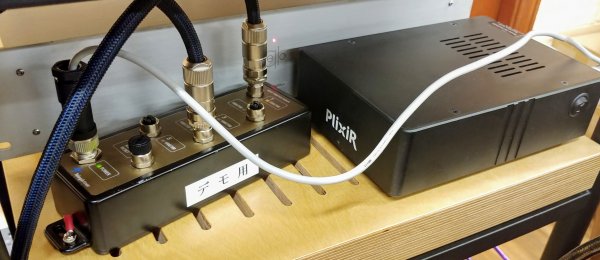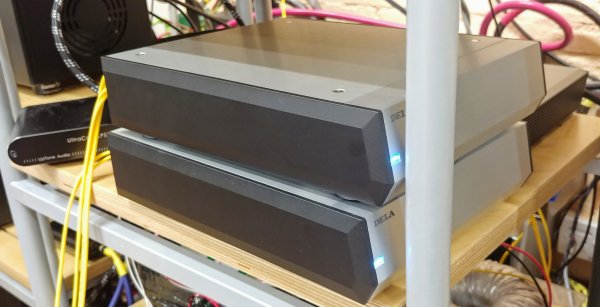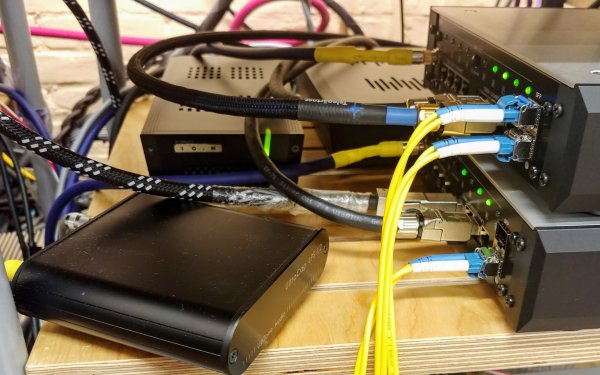One other switch to consider is the Melco S100 as reported on by
@hols and
@CKKeung and others. This is the final switch I have been interested in auditioning and I have it now:
This switch actually belongs to
@seeteeyou and is the same switch that
@hols,
@austinpop,
@nenon, and perhaps others have evaluated and so this switch is well traveled from Japan to Hong Kong, Chicago, Austin (Texas), and now the Sierra Nevada foothills of northern California. This switch can tell some stories, lol.
I actually have a second Melco switch (a Buffalo that uses the exact same board as the Melco that was modded by
@nenon) that was sent to me courtesy of
@austinpop which has allowed me to evaluate the impact of 2 of these switches. While there are subtle differences between the 2, for my practical purposes, I find them to be equivalent and so I will refer to them as one in this report.
I also presently have a Sonore opticalModule on loan:
I decided to also try an alternative SFP, this time a wide-temperature 10G model from Finisar to compare against the MGB-TLX SFP from planetechusa.com that has been my reference since early February:
I currently have 6 switches on hand in addition to the EdgeRouter and SB8200 modem (and so 8 network devices). Powering each one properly was a challenge but I managed to apply either an SR7 or SR4 rail to each device. In each instance, a better power supply made a significant difference, much larger than differences between Ethernet cabling.
As for the impact of 6 network switches, through repeated addition and subtraction of each switch, it was easy to hear each switch's individual impact. Much has been said about applying your best switch last (closest to your server) but to my ears, the impact of the 1st switch is no less than the impact of the last switch. It's as if the character imposed by the switch on the signal is forever embedded into the signature and this signature can be modulated in some way by subsequent switches but not removed. I'm confident that if I had 10 or 20 switches in series, they would each contribute something. In my case, combining all 6 switches did not provide a net positive.
Is the contribution of a good switch just "isolation?" I'm not so sure. I think each switch is probably offering some isolation but then also imprinting its own noise signature that can either be positive or negative and this new signature becomes embedded to the new signal. With the etherRegen, for example, there is this famous moat that is advertised but once you cross the moat, the output stage of this switch will have its own signature based on the properties of the chipset, clock, resistors, capacitors, PCB traces, dielectric coefficient of the PCB, etc. It turns out network equipment is also prone to considerable EMI emissions that if not properly contained, can significantly impact surrounding components (i.e. other switches and worse, your DAC). As a proof of concept, I entered the "B" side of the eR so as to utilize its moat. I then connected the SFP side of the eR to the SFP side of the Melco. If the eR's moat already is providing supreme isolation, then why is the Melco altering the sound further (and for the better)? This is why I say each switch must be imprinting its own signature and that if you decide to place even 100 switches in your chain, each switch will continue to alter the sound.
I presently do not have the M12 Gold in my possession but I will have it again soon. That switch is just too good not to own and I really miss it. Presently, I have the equivalent of 2 Melco S100s, 2 SOtM sNH-10Gs, an etherRegen, and an oM. To my ears, it almost doesn't matter what order you have them in. If I have the sNH-10G in the first position or the last, I can hear it's qualities quite easily. It offers the best depth of any of the switches I have heard but it also imparts a certain thinness. This thinness was never a problem with my previous servers but it is not a quality I can accept with the Extreme and so I will be moving on from it. For some time now, the etherRegen has been functioning as an FMC in my system as I do not prefer its "B" side with the Extreme. I believe many Extreme owners feel the same way. The eR provides nice body and when powered well, excellent dynamics and liveliness, especially with the MGB-TLX SFPs from planetechusa.com. The oM performs similarly, maybe slightly better and for less money but ultimately, what either the eR or oM offers pale in comparison to what the Melco S100 offers and do not offer the resolution of the Melco. The Melco S100 is very obviously the superior switch to my ears and while this is mostly likely system dependent, dual Melco S100s are even better and so I see my final network configuration finally starting to take shape.
What the Melco S100 offers that no other switch can offer to the same degree is sound staging, dynamics, and fullness. While I do not presently have the M12 Gold in my possession, there is no doubt in my mind it cannot compete with the Melco when it comes to these qualities. With 2 of them in series and when powered by SR7 rails, even at low listening volumes, the dynamics and fullness of the midbass and midrange are just incredible. They are behaving literally like active gain stages but in the digital domain. Moreover, it's not "one note" bass, it's very well defined bass with excellent bass texture that is especially appreciated when listening to a solo cello or double bass. The sound stage and air is also beyond any switch I have heard. With complex large orchestral music, you really get a better sense of the dimensions of the venue. The SOtM comes close and provides better depth and detail delicacy but again sounds thin. In comparison, the eR and oM sound flat and add nothing to what the S100 already brings. My eR will now be retired as well.
Based on the balance of qualities I seek, for now, my anticipated network will look as follows:
SB8200 modem > copper > EdgeRouter > copper > Melco/Buffalo > copper > M12 Gold > copper > Melco/Buffalo > fiber > Extreme.
For my preferences, fiber needs to be somewhere and I prefer it straight to the Extreme and yes, the quality of copper Ethernet cabling still makes a significant difference. As for the SFPs, the more expensive Finisars did not sound as good as the MBG-TLX from planetechusa.com.
Consider the above as one person's perspective. Obviously, YMMV.













